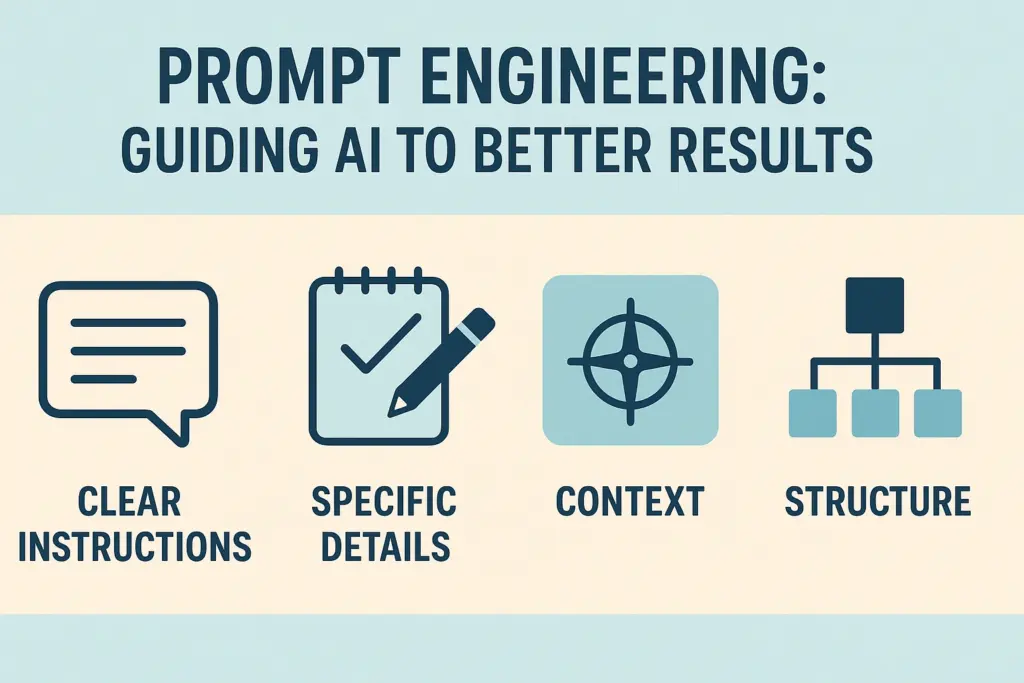Introduction
Artificial Intelligence has become a trusted assistant in coding, marketing, content creation, and even daily life. But the secret to unlocking its full potential lies in one crucial skill: Prompt Engineering. This emerging discipline is all about designing clear, detailed instructions that guide AI to produce relevant, accurate, and context-aware results.
In short: the quality of your prompt directly shapes the quality of the AI’s output.
What is Prompt Engineering?
Prompt engineering is the practice of crafting well-structured instructions (prompts) for AI models. A prompt can include context, desired format, role assignment, or examples that help the AI understand exactly what you want.
Think of it like talking to a highly intelligent assistant: the clearer your directions, the better the response.
For example:
- Instead of asking “Write code for factorial”, a refined prompt would be “Write a Python function that calculates the factorial of a given number using recursion.”
- The second prompt gives the AI context, language, and structure, making the output far more precise.
Why Prompt Engineering Matters
AI is only as useful as the instructions it receives. Strong prompt engineering:
- Improves accuracy → reduces vague or irrelevant answers.
- Saves time → fewer guess-and-check retries.
- Enhances creativity → provides direction for marketing, writing, and design.
- Boosts productivity → from debugging code to drafting reports.
According to experts, well-designed prompts act like guardrails—keeping AI focused, efficient, and reliable.
Use Cases of Prompt Engineering
1. For Developers (Coding & Debugging)
Software engineers use prompts to:
- Generate code snippets.
- Debug existing scripts.
- Translate code between languages.
💡 Example Prompt:
“Write a Python function that takes a list of numbers and returns only the prime numbers in ascending order.”
2. For Marketers (Content & Campaigns)
Marketers use prompts to:
- Generate blog outlines, ad copy, or email campaigns.
- Adapt tone for different audiences.
- Create SEO-friendly website text.
💡 Example Prompt:
“Create 10 blog titles about CRM software, each with a 50-word introduction targeting small business owners.”
3. For General Everyday Tasks
Students, professionals, and casual users rely on prompts to:
- Summarize long articles.
- Translate text into different languages.
- Get answers in a specific tone or role.
💡 Example Prompt:
“Summarize the following article on climate change in 5 bullet points, written for high school students.”
Strategies for Effective Prompt Design
✅ Chain-of-Thought Prompting
Guide the AI to reason step by step. Example: “Explain how solar panels work, step by step, as if teaching a beginner.”
✅ Few-Shot or One-Shot Prompting
Provide examples of input and output before your actual request. This helps AI learn the format.
✅ Role or Persona Assignment
Tell AI who it should act as. Example: “You are a financial advisor. Explain cryptocurrency to a beginner investor.”
✅ Be Specific & Concise
Include length, format, or style instructions: “Explain in under 150 words using bullet points.”
Tools That Make Prompt Engineering Easier
- OpenAI Playground – Experiment with wording, temperature, and formatting.
- PromptLayer – Analyze and optimize prompts with version tracking.
- FlowGPT – Discover prompts shared by the community.
Other advanced platforms include LangChain and Microsoft PromptFlow, which support complex workflows and automation.
The Future of Prompt Engineering
The field is evolving rapidly. In the near future:
- Auto-Prompting – AI will generate and refine its own prompts.
- Multi-Agent AI – Systems where different AI agents ask and answer each other’s questions.
- Prompt Architects – Instead of writing individual prompts, humans will design workflows that AI follows.
Yet, even as AI gets smarter, clear human prompting remains essential for accuracy, safety, and reliability.
Key Takeaways
- Prompt engineering = the skill of guiding AI with precise instructions.
- Better prompts = better results in coding, marketing, and daily tasks.
- Core strategies: chain-of-thought, few-shot examples, and role assignment.
- Top tools: OpenAI Playground, PromptLayer, FlowGPT.
- The future: auto-prompting, multi-agent systems, and AI-led refinements.
Why It Matters Globally & Locally
Prompt engineering is gaining demand worldwide. From tech hubs like Bangalore and San Francisco to digital marketing firms in London and Dubai, professionals are integrating prompt skills into daily work.
If you search for:
- “Prompt engineering training in India”
- “AI prompt workshop near me”
- “Best online prompt engineering course in USA”
👉 You’ll see a growing number of courses, bootcamps, and workshops tailored to local audiences.
This proves prompt engineering isn’t just a tech trend—it’s a career skill with global reach and local opportunities.
